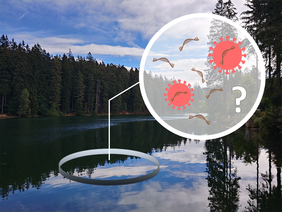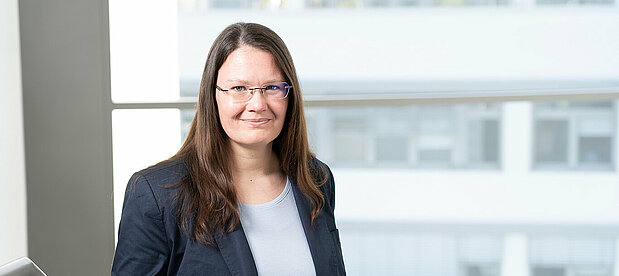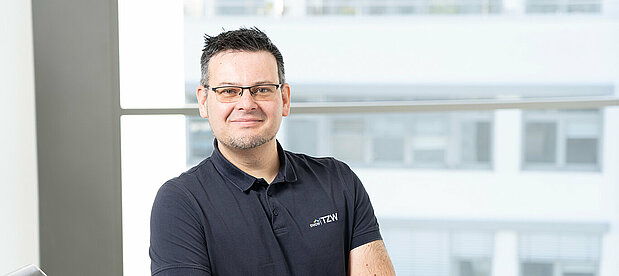At the onset of the COVID-19 pandemic, questions were raised about the safety of drinking water with respect to the novel coronavirus. Although theoretical considerations suggest that the spread of SARS-CoV-2 via drinking water is highly unlikely, there no measured data on the spread of the virus in the aquatic environment were available. Such data have been obtained in this project.
Since it was known that some infected people shed the virus in their faeces, there was concern that the virus could be introduced into the aquatic environment via wastewater, including water used for drinking. Based on the results of a literature review we conducted, the spread of SARS-CoV-2 via drinking water is extremely unlikely. However, this conclusion is not based on surveillance data but on theoretical considerations.
In most cases, virus detection is based on the detection of nucleic acid and does not allow differentiation between infectious and non-infectious viruses. As a first step, a methodology for the detection of SARS-CoV-2 RNA in raw water samples has been established. The procedure involves the concentration of viruses from a larger volume (10-100 L) by ultrafiltration, secondary enrichment by polyethylene glycol precipitation, extraction of viral nucleic acids and detection of SARS-CoV-2 specific genes by digital droplet PCR. In addition, the ability to differentiate between intact and non-intact viruses using innovative PCR-based methods was tested. The detection of long nucleic acid fragments (long amplicon PCR) for viruses with an RNA genome proved unsuccessful. However, the use of the dye propidium monoazide (PMA-PCR), which penetrates non-intact viruses, binds to their nucleic acid and thus prevents PCR amplification, is an option for differentiating between intact and non-intact viruses.
One focus of the project was to investigate the presence of SARS-CoV-2 in raw water. A total of 91 surface water samples and 9 groundwater samples were analysed for the presence of SARS-CoV-2. SARS-CoV-2 RNA was not detected in any of the samples.
The Pseudomonas phage phi6 was selected as a surrogate for enveloped viruses and the coliphages MS2 and phiX174 for non-enveloped viruses for laboratory testing of viral behaviour in the treatment process. The results of the tests show that treatment with chlorine, ozone and UV radiation can inactivate both enveloped and non-enveloped viruses. However, enveloped viruses were not always inactivated more effectively than non-enveloped viruses, due to the different mechanisms of action and points of attack of the disinfection processes. However, the data obtained in combination with ongoing studies clearly show that enveloped viruses such as SARS-CoV-2 are effectively inactivated by chlorination, ozonation or UV irradiation due to their structure (membrane envelope and single-stranded RNA genome).
Overall, the results of this project confirm that the spread of SARS-CoV-2 via drinking water is highly unlikely. The multi-barrier system of the drinking water supply and, the disinfection processes provide additional effective protection against possible contamination with SARS-CoV-2.
Publications:
Stange C., Ho J., Tiehm A.: Nachweisverfahren und Relevanz von SARS-Coronavirus-2 in der Wasserwirtschaft. KA Korrespondenz Abwasser, Abfall 68, 1: 29–39 (2021)
Stange C., Ho J., Tiehm A.: SARS-CoV-2 im Kontext der Wasserversorgung. DVGW energie | wasser-praxis (EWP), 12/2020: 50–55 (2020)
Stange C., Ho J., Tiehm A.: SARS-CoV-2 im Kontext der Wasserversorgung. Veröffentlichungen aus dem Technologiezentrum Wasser, ISSN 1434-5765, TZW-Band 93 (2020)
Stange C., Ho J., Tiehm A.: Entwicklung von Monitoringmethoden für SARS-CoV-2 in Rohwässern und vergleichende Untersuchungen von behüllten und unbehüllten Viren in der Aufbereitung. Abschlussbericht zum DVGW-Vorhaben W 202014
The volumes of the TZW publications can be ordered here.

![[Translate to English:] Prüfstelle-Produktprüfung_Teststand Test centre and product testing](/fileadmin/_processed_/0/9/csm_TZW-Karlsruhe_Pruefung_Geraete-Teststand_377188946c.jpg)


























